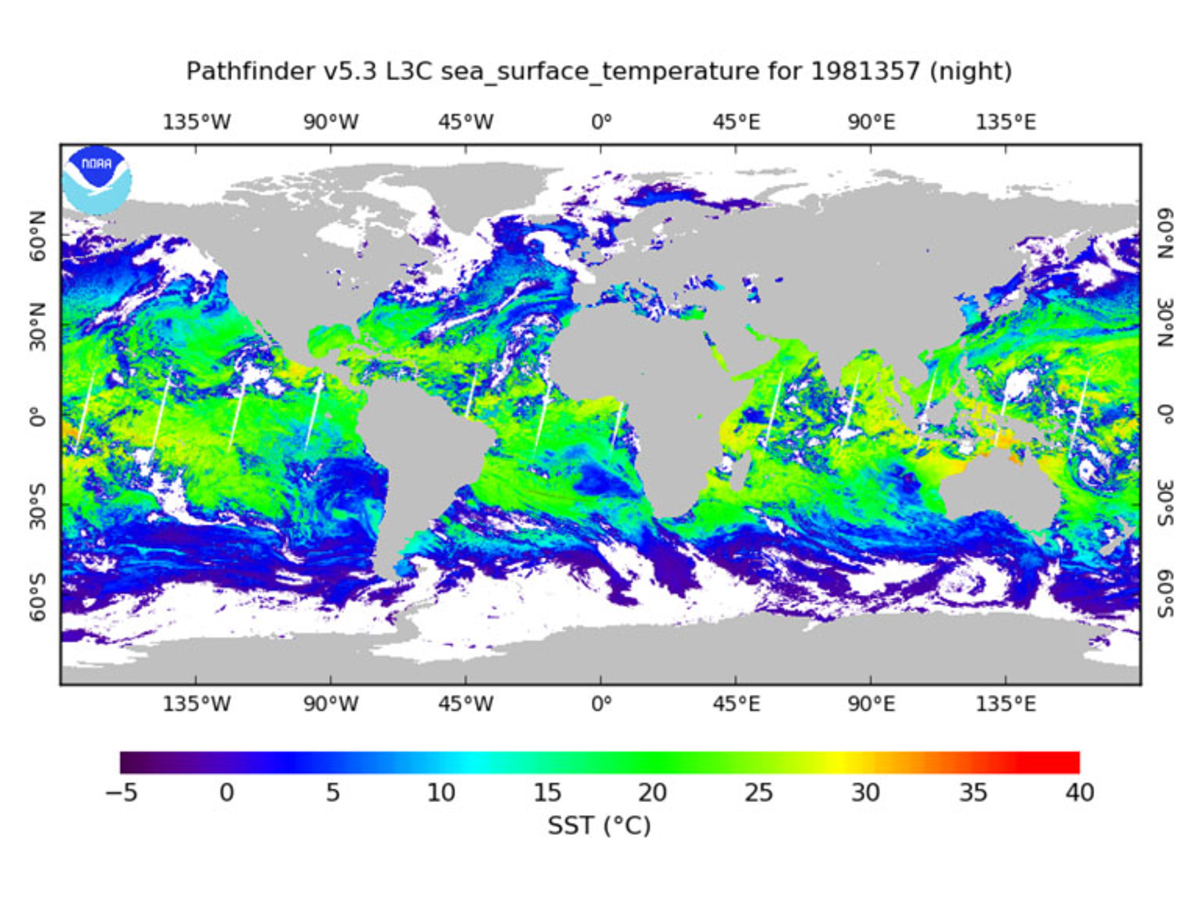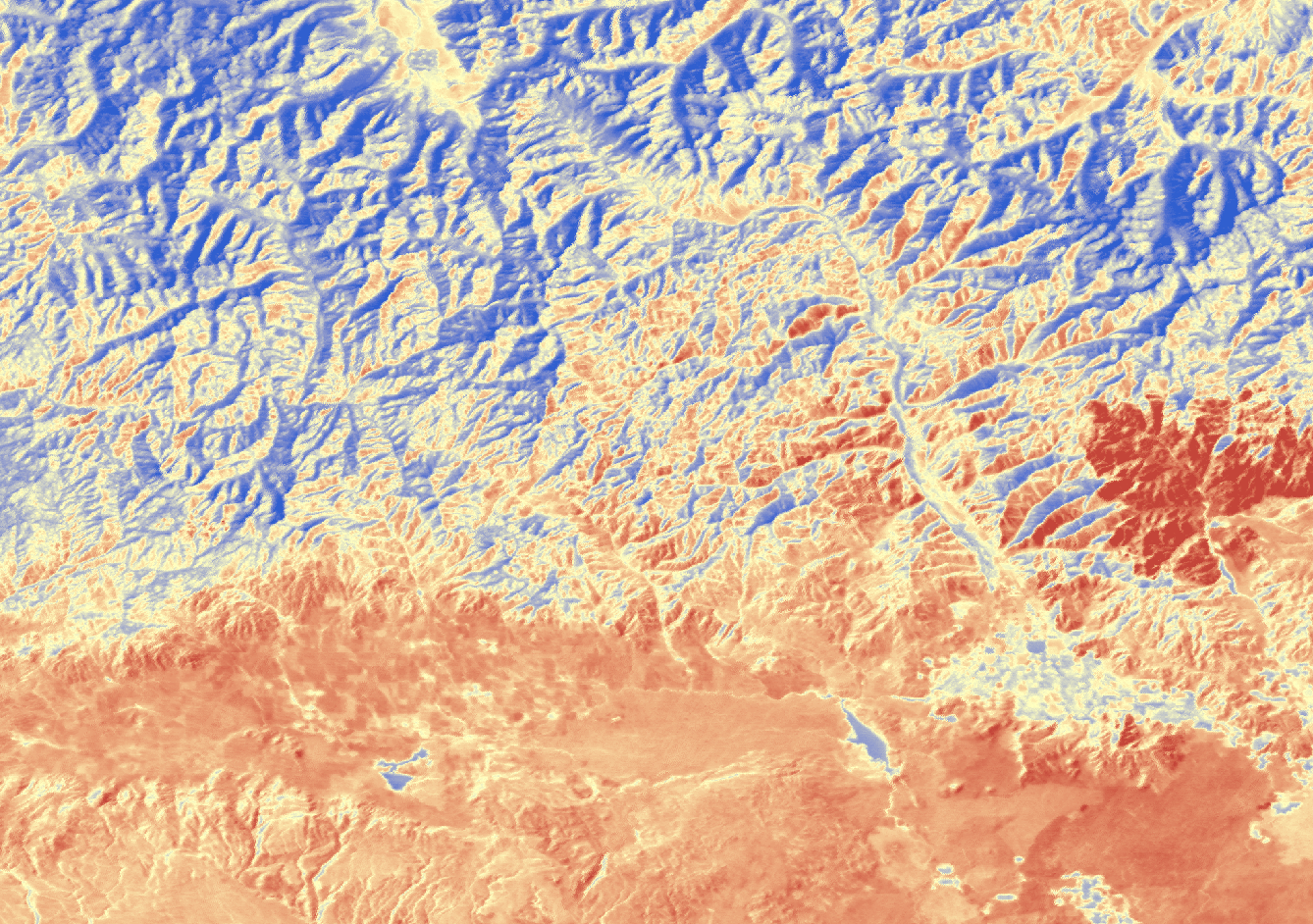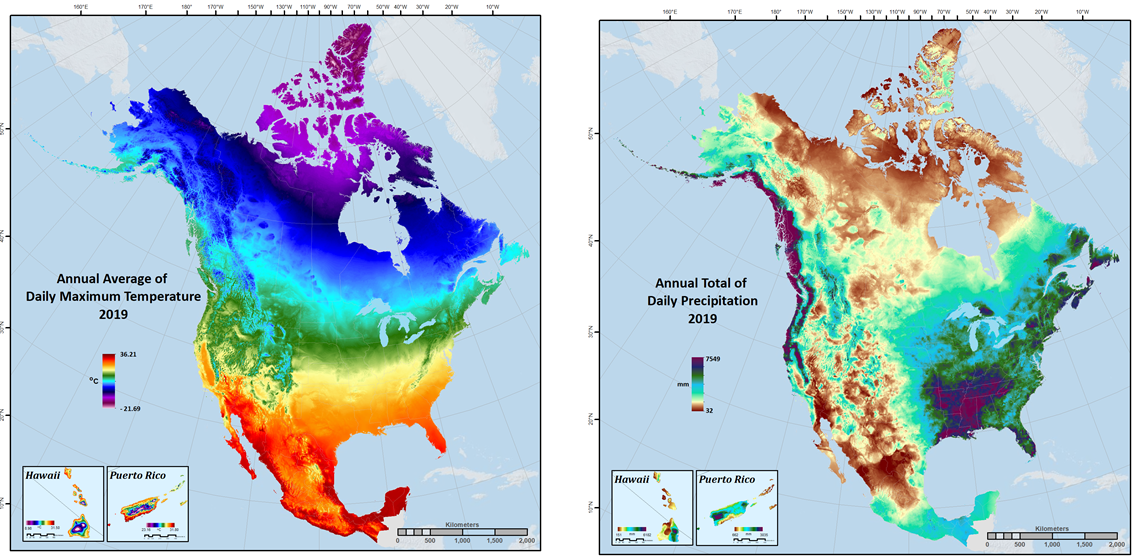These datasets are used by the various DAP data access tutorials located here. They are listed in order from smallest to largest. Each of the following sections contains links to the source dataset at the original publishers site, and links to a copy of the dataset granule hosted at test.opendap.org
1. NASA Global High Resolution Sea Surface Temperature (GOES-16 Satellite)
-Example.png)
These data are regional and part of the Group for High Resolution Sea Surface Temperature (GHRSST) Level 3 Collated (L3C) dataset covering the America Region based on retrievals from the Advanced Baseline Imager (ABI) on board the Geostationary Operational Environmental Satellite-16 (GOES-16).
| file_name |
20220812010000-OSISAF-L3C_GHRSST-SSTsubskin-GOES16-ssteqc_goes16_20220812_010000-v02.0-fv01.0.nc |
| BoundingBox |
lon_max = -15, lat_max = 60, lon_min = -135, lat_min = -60 |
| Native File Size |
9,626,842 bytes |
| Total Variables |
19 |
| Range Variables |
16 |
| Uncompressed Range Variable |
11,520,000 bytes |
1.1. Publisher: NASA
| granule_url | |
| dap_service_url | |
| DAP4 Links | |
| DAP2 Links |
1.2. Host: test.opendap.org
2. NOAA GHRSST, 4km (Pathfinder Satellite)

This data product is a long-term Climate Data Record (1981–present) that builds on the historic aspect of Pathfinder Sea Surface Temperature (SST) (Saha et. al 2018). It contains global, twice-daily (Day and Night) 4km SST derived from measurements captured by Advanced Very High Resolution Radiometer (AVHRR) instruments aboard NOAA polar-orbiting satellites.
2.1. Test Granule: 01/06/1996 Nighttime
| file_name |
19960106043137-NCEI-L3C_GHRSST-SSTskin-AVHRR_Pathfinder-PFV5.3_NOAA14_G_1996006_night-v02.0-fv01.0.nc |
| Native File Size |
39,007,534 bytes |
| Total Variables |
18 |
| Range Variables |
11 |
| Uncompressed Range Variable |
74,649,600 bytes |
2.1.1. Publisher: NOAA
2.1.2. Host: test.opendap.org
2.2. Test Granule: 01/06/1996 Daytime
| file_name |
19960106134722-NCEI-L3C_GHRSST-SSTskin-AVHRR_Pathfinder-PFV5.3_NOAA14_G_1996006_day-v02.0-fv01.0.nc |
| Native File Size |
39,106,029 bytes |
| Total Variables |
18 |
| Range Variables |
11 |
| Uncompressed Range Variable |
74,649,600 bytes |
2.2.1. Publisher: NOAA
| TDS Dataset Page | |
| granule_url | |
| dap_service_url | |
| DAP4 |
dmr html DAP4 Services Do Not Appear to Be Available For This Granule. |
| DAP2 |
2.2.2. Host: test.opendap.org
3. NASA/JPL/USGS ECOSTRESS

The ECOsystem Spaceborne Thermal Radiometer Experiment on Space Station (ECOSTRESS), will monitor one of the most basic processes in living plants: the loss of water through the tiny pores in leaves. When people lose water through their pores, the process is called sweating. The related process in plants is known as transpiration. Because water that evaporates from soil around plants also affects the amount of water that plants can use, ECOSTRESS will measure combined evaporation and transpiration, known as evapotranspiration (ET). ECOSTRESS will address 3 science questions:
3.1. Test Granule: ECOSTRESS Land Surface Temperature and Emissivity Daily L2 Global 70 m 1/6/1996
The ECOsystem Spaceborne Thermal Radiometer Experiment on Space Station (ECOSTRESS) mission measures the temperature of plants to better understand how much water plants need and how they respond to stress. ECOSTRESS is attached to the International Space Station (ISS) and collects data over the conterminous United States (CONUS) as well as key biomes and agricultural zones around the world and selected FLUXNET validation sites. A map of the acquisition coverage can be found on the ECOSTRESS website.
| file_name |
ECOSTRESS_L2_LSTE_26387_008_20230302T100304_0601_02.h5 |
| Native File Size |
150,254,547 bytes |
| Total Variables |
??? (I have no idea what’s going on in this dataset!) |
| Range Variables |
15 |
| Uncompressed Range Variable |
60,825,600 bytes |
3.1.1. Publisher: USGS
| granule_url | |
| dap_service_url | |
| DAP4 | |
| DAP2 |
3.1.2. Host: test.opendap.org
4. NASA Daymet Precipitation

NASA Daymet Version 4 R1 data are gridded estimates of daily weather parameters for North America, Hawaii, and Puerto Rico. Daymet variables include the following parameters: minimum temperature, maximum temperature, precipitation, shortwave radiation, vapor pressure, snow water equivalent, and day length.
4.1. Test Granule: Daymet 1996 North America Daily V4R1 Precipitation
| file_name |
daymet_v4_daily_na_prcp_1996.nc |
| Native File Size |
3,810,812,334 bytes |
| Total Variables |
9 |
| Range Variables |
1 |
| Uncompressed Range Variable |
92,123,153,000 bytes |
4.1.1. Publisher: NASA
4.1.2. Host: test.opendap.org
| dap_service_url |
http://test.opendap.org/opendap/hyrax/tutorials/daymet_v4_daily_na_prcp_1996.nc |
| DAP4 | |
| DAP2 |
5. NASA: Daily MUR SST, Final product
-MUR-Example.png)
| file_name |
20220531090000-JPL-L4_GHRSST-SSTfnd-MUR-GLOB-v02.0-fv04.1.nc |
| Native File Size |
730,585,356 bytes |
| Total Variables |
9 |
| Range Variables |
6 |
| Uncompressed Range Variable |
1,295,928,000 bytes |
5.1. Publisher: NASA PODACC
| granule_url | |
| dap_service_url | |
| DAP4 | |
| DAP2 |
5.2. Host: test.opendap.org
- dap_service_url
-
http://test.opendap.org/opendap/hyrax/tutorials/daymet_v4_daily_na_prcp_1996.nc
- DAP4
- DAP2
